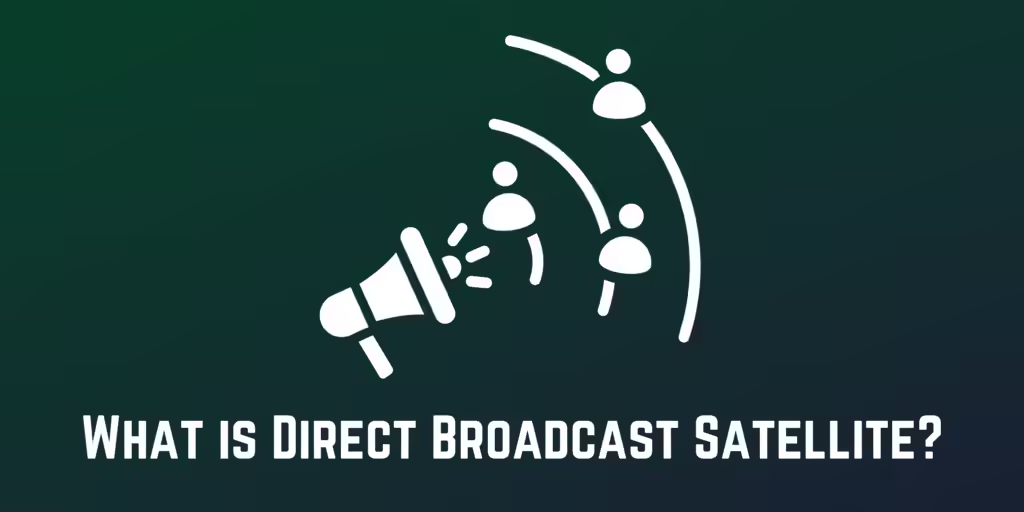Direct Broadcast Satellite(DBS) is a transmission technology that uses satellites orbiting the Earth to transmit radio and TV signals directly to the general public. The satellites stationed in the geostationary orbit send signals to a dish antenna installed at the customer’s residence, which then decrypts the signal and displays the content on the user’s TV.
This article talks in detail about DBS technology, how it works, and its benefits and drawbacks.
Contents
How Does Direct Broadcast Satellite Work?
DBS works by using satellites in the geostationary orbit to transmit signals to households and businesses. The signals are encrypted and transmitted to an earth station or dish where they are decrypted and delivered to the user’s TV.
The core elements of DBS technology are:
Geostationary Satellites
These are satellites that revolve around the Earth at an altitude of approximately 36,000 km above the equator. The transmitters on these satellites send the broadcast signals back.
Broadcasting Center
The broadcasting center links the television channels and the satellites. It gets signals from multiple sources and sends a broadcast to the satellite, which receives the transmission and relays it back to the Earth.
Compression and Encryption
The content is compressed before transmission in order to save bandwidth. It is also encrypted to protect copyright and prevent non-paying users from accessing the content.
Up-linking
An uplink location is used to transmit the compressed and encrypted content to the satellites. The uplink station uses an antenna to transfer the content received from the broadcasting center to the satellite.
Satellite Receiver
This is usually a dish antenna at the user’s home that receives the satellite transmissions.
Decoding
The decrypted content is displayed on the user’s TV. This is done via a conditional access system(CAS) using a decryption key that must be entered before the data is accessed.
Advantages of DBS
Wide range of Channels
DBS services offer customers a wide range of channels and packages. You can select them based on your interests and preferences.
Signal Performance
DBS has high-quality signal reception with less interference as compared to other technologies. This enhances the quality of audio and visuals lending to an overall better experience.
Accessibility
DBS is particularly useful in areas where cable or terrestrial networks are unavailable or of subpar quality. It has helped in bringing broadcast access to previously unserved areas.
Portability
DBS is easy to transport and install, making it a good choice for those who are frequently on the move.
Limitations of DBS
Weather Dependence
The quality of the DBS signal is heavily dependent on weather conditions. Bad weather, such as heavy rains and strong winds, can interfere with signal reception, interrupting the broadcast.
Setup Cost
Getting started with DBS is expensive compared to regular cable TV. This is because equipment like a dish antenna is needed for it which is also to be installed by a professional.
Expensive Subscription
The monthly subscription charges for DBS packages can easily add up over time. This is especially true if you opt for additional or premium channels.
Latency
DBS might experience signal latency if you use interactive games or watch live events with it. The technology will not be able to handle the load and deliver a seamless experience.
What is the Difference Between DBS and DTH?
Both DBS and DTH are satellite-based broadcast technologies. They decrypt and transmit signals received from a satellite to the user’s TV.
The main difference between DBS and DTH is in the size of the dish antenna used. The former uses a large dish antenna to catch signals ricocheted off a satellite, while the latter uses small ones to get signals directly from the satellite.
Further, DBS transmits signals from satellites at a particular frequency band, while DTH can transmit signals over a wide range of frequencies.
Conclusion
DBS is a technology that uses satellite signals to deliver content directly to households and businesses. It has helped in bringing television access to areas with little to no cable services. The technology is the preferred choice for receiving programming in developed markets.
DBS offers a wide range of channels with excellent audio-visual quality and is a better choice for people who are constantly on the move.





